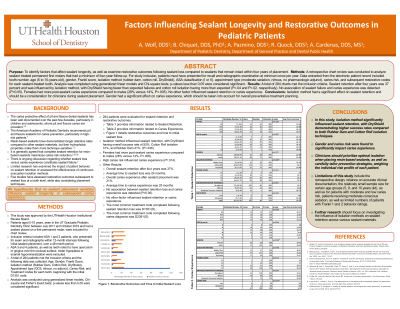Preventive
150 - Factors Influencing Sealant Longevity and Caries Outcomes in Pediatric Patients

- AW
Amanda Wolf, DDS
Pediatric Dentistry Resident - PGY2
University of Texas Health Science Center-Houston
University of Texas Health Science Center-Houston
Houston, Texas, United States - BC
Brett Chiquet, DDS,PhD
Universtity of Texas Health Science Center - Houston
- KP
Katherine Pazmino, DDS, MSD, MBA
Universtity of Texas Health Science Center - Houston
- RQ
Ryan Quock, DDS
Universtity of Texas Health Science Center - Houston
- AC
Antonio D. Cardenas, DDS, MS
Universtity of Texas Health Science Center - Houston
- AC
Antonio D. Cardenas, DDS, MS
University of Texas Health Science Center - Houston
Houston, Texas, United States - BA
Bhavini Acharya, BDS, MPH
Associate Professor; Program Director, Pediatric Dentistry Residency
University of Texas Health Science Center-Houston
Houston, Texas, United States
Presenting Author(s)
Co-Author(s)
Research Mentor(s)
Program Director(s)
Purpose: To identify factors that affect restorative outcomes after sealant loss compared to sealants that remain intact or caries free within four years of placement.
Methods: A retrospective chart review was conducted to analyze sealant treated permanent first molars that had a minimum of four-year follow-up. For study inclusion, patients must have presented for recall and radiographic examination at minimum once per year. Data extracted from the electronic patient record included tooth number, age (5 to 10-years-old), gender, Frankl score, isolation method (rubber dam, cotton roll, DryShield), ASA classification (I or II), appointment type (moderate sedation, nitrous, no pharmacologic adjunct), caries risk, and subsequent restorative codes for each sealant-treated tooth. Analysis was completed using generalized linear models and Chi-square tests; p-values less than 0.05 were considered significant.
Results: A total of 284 charts met the inclusion criteria. Sealant retention after four years was 36% and was influenced by isolation method, with DryShield having fewer than expected failures and cotton roll isolation having more than expected (P=.04 and P=.02, respectively). No association of sealant failure and caries experience was detected (P >.05). Females had more post-sealant caries experience compared to males (28% versus 14%, P=.005). No other factor influenced sealant retention or caries experience.
Conclusions: Isolation method had a significant effect on sealant retention and should be a consideration for clinicians during sealant placement. Gender had a significant effect on caries experience, which should be taken into account for overall preventative treatment planning at recall appointments.
Identify Supporting Agency and Grant Number:

.jpg)